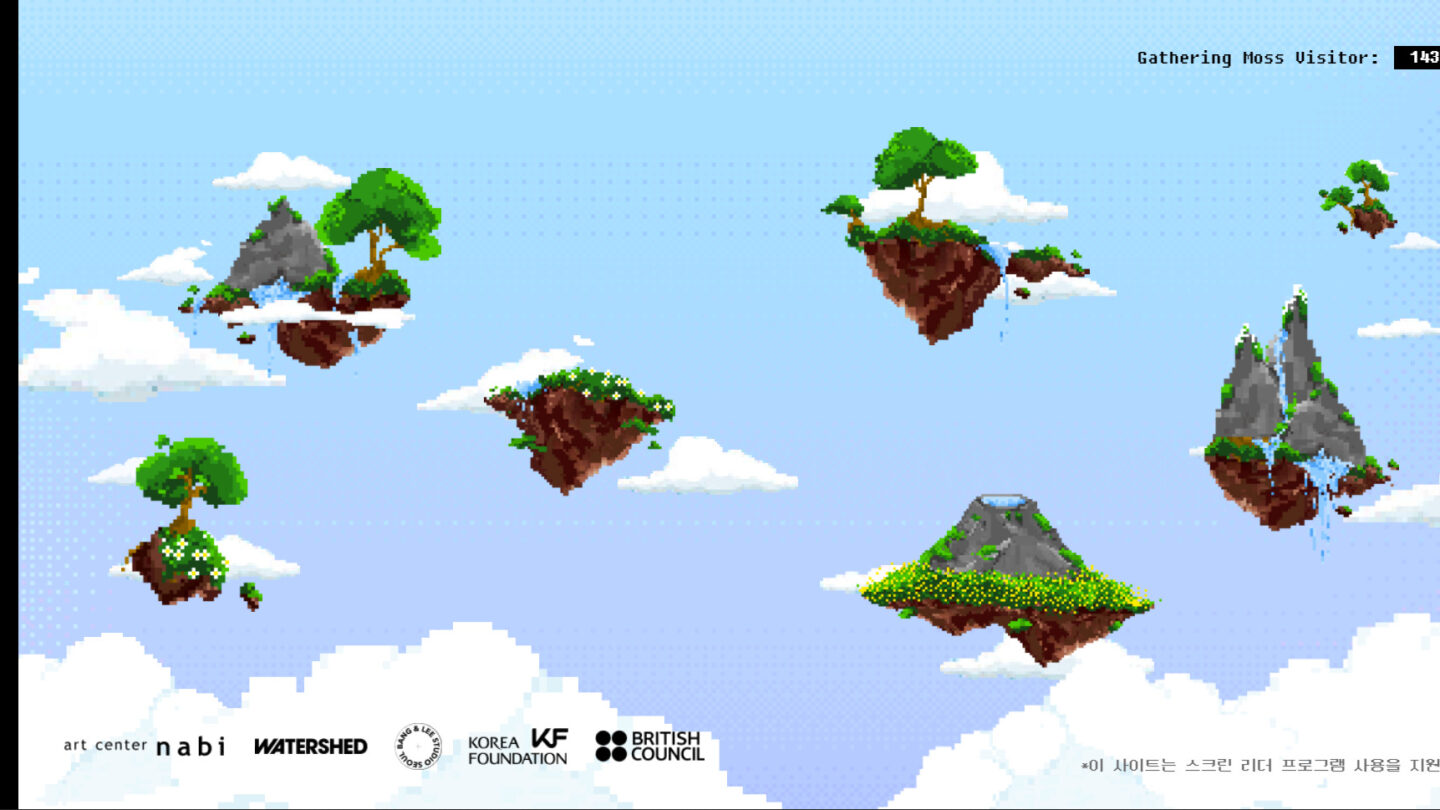Gathering Moss: Terraforming a Digital World
In November 2021, the UN Climate Change Conference brought together world leaders, media representatives, participants, protesters, and spectators to Glasgow. For two weeks, the world was transfixed, waiting to hear decisions made about all facets of the climate crisis – the science, the solutions, and the potential for action. Elsewhere, on two sides of the fragile planet, seven young artists from South Korea and the UK met online, to collaborate, create, and cultivate art that responded to the ongoing crisis.
Art Centre Nabi based in Seoul in South Korea and Watershed, based in Bristol, England, co-hosted the Korea-British global cultural project ‘Gathering Moss‘: a digital landscape populated with artistic ideas made in response to the climate emergency. It invites visitors to explore, to imagine the future of our rapidly heating world, to be hopeful, and to act.
The project began with a 5-day Creative Camp hosted by Art Centre Nabi and Watershed in collaboration with The Studio in Bath and Bristol+Bath Creative R+D. It was an invitation to collectively consider the climate crisis and generate artistic ideas with a programme of discussions, lectures, and workshops led by other artists and climate researchers. The participants were encouraged to respond to:
- REIMAGINE space for a post-covid, rapidly heating world and explore connections between online and physical, local and global, utopian and dystopian futures.
- EXPLORE play as a process for changing the relationship of people to the planet
- CONNECT with invited practitioners and with each other, to share understanding of the climate crisis and its consequences, from the perspective of differing geographical locations.
- DEVELOP artistic ideas to provoke climate action and act to ‘terraform’ a digital landscape.
At its heart, Gathering Moss was a project of collaboration, utilising the online platforms we have assimilated to over the past two years. Speaking to the participants, it’s clear this collaboration is something they had been missing, or hadn’t yet had the opportunity to explore, in their own creative practice. Heather Gibson, creator of the piece ‘Coronary Synthesis’ for the platform, was excited to collaborate in this way, ‘My art journey started during lockdown. So far it’s definitely been a solitary process, I will definitely jump on any chance to collaborate.’ Inez Solomon, creator of ‘The Last Choice’ for The Gathering Moss platform, had a similar experience, ‘I came out of sixth form in the pandemic. It had been a long time since I had the opportunity to bounce ideas off each other, it’s so inspiring.’
Out of the Creative Camp came five brand new experimental works on themes such as microplastics, personal responsibility, global heating, distraction, and love, including work from South Korean media artists Bang & Lee, who present hybrid works in response to the environment of Jeju Island, an island in South Korea that has already seen the devastating effects of climate change with rising sea-levels and changes to the marine ecosystem. The five works, created in an incredibly short space of time, share the perspectives of their generation on climate change at this critical crossroads for humanity.
Exploration of the climate crisis and other social issues was not unfamiliar territory for the young artists involved. Heather Gibson (who creates art under the pseudonym HAG), has always created ‘socially conscious’ art, using the mediums she works in to explore the human condition and add her voice to the issues she cares deeply for, ‘If it’s not saying something or doing something then art for me feels a bit pointless.’ Inez Solomon ‘wrote a few poems about Black Lives Matter in June 2020 which got quite a lot of attention on the internet, that was my first escapade into writing for that sort of reason.’ This inspired her to carry on creating art for social justice, ‘I will definitely carry on with it. It’s easier to get people to interact and listen when it’s not just shoving words down their throat or telling them what they should do…’
The team involved in Gathering Moss weren’t the only artists creating responses to COP26. In Bath, people walking over Pulteney Bridge were likely to spot The Sinking House floating in the river Avon. This installation by artist Anna Gillespie depicts a figure sitting on the roof of a half-submerged house, gripping tightly to a banner keeping them afloat, the banner reads “COP26” to represent the lifeline that the conference had become. Gillespie comments, ‘Contributing to this message through the arts is just a small part of what I can do to ensure protecting our environment is of the top priority.’
Likewise, Tom Forsey, creator of ‘The Future? We Choose‘ for Gathering Moss, notes the place art holds within activism, and where best he feels his skill set could be of use, ‘I don’t think I’m the kind of person that would go and lie in the road – although I do think that is a constructive thing to do – I feel like I could use my skill set to reach a wider audience and have an impact in a different way.’
The Gathering Moss project illustrated many things including the power of art as activism, the importance of creative collaboration, and the way we frame discussion surrounding the climate crisis. Gathering Moss also highlights the power of what young artists can create when empowered and supported with their ideas, and we look to more projects like this to continue to do so.
Please dive in and explore the platform here, and be inspired to help terraform a new future.
Read the full interviews with the UK participants here.
Elisha Westmore
